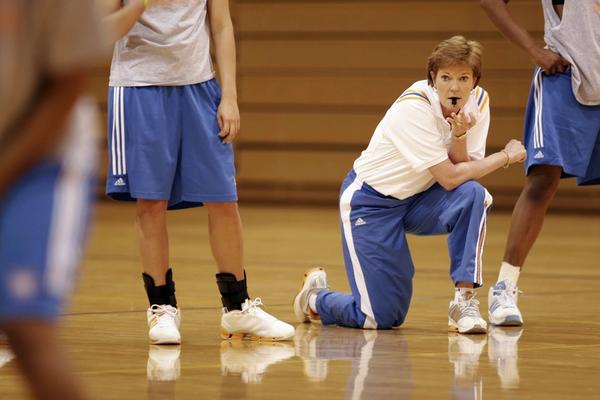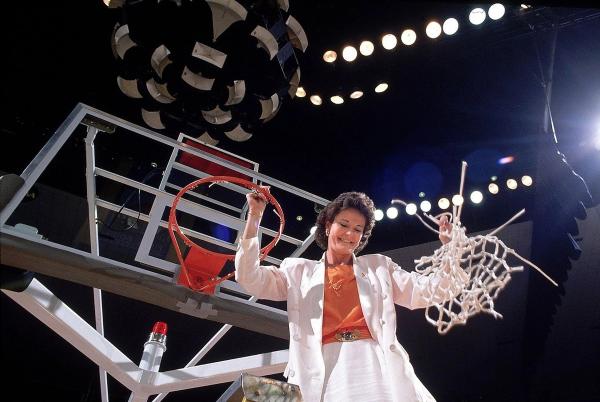Legends of the Game: Pat Summitt

🏀 The history
The beginning: Born, raised, and beloved in the Volunteer State, Summitt was a Tennesseean through and through. She learned to play basketball in the barn loft on her parents’ farm before joining the Cheatham County Central High School team.
- Two years before Title IX — the landmark U.S. civil rights law passed in 1972 that ensured equal educational opportunities regardless of gender — Summitt began competing collegiately at the University of Tennessee at Martin, where she graduated as the team’s all-time leading scorer.
- Her playing experience extended to the international stage where she co-captained the 1976 U.S. Olympic Team winning the first-ever women’s hoops Olympic silver medal in Montréal.
At the helm: Twenty-two-year-old Summitt secured her first head coaching position at the University of Tennessee in 1974, and the rest, as they say, is history. She spent 38 years leading the Lady Volunteers, amassing a stunning 1,098-208 record.
- While Summitt’s signature stare was intimidating and she demanded a lot of her players, she was simultaneously compassionate and kind. She maintained relationships with her student-athletes long after they graduated, continuing to empower and support them.
- Summitt demonstrated that women, particularly women in sport, can be strong, tough, and powerful — she single-handedly transformed the Lady Vols into a perennial powerhouse and a national brand during her tenure.
The legacy: The basketball world lost the legendary bench boss far too soon: Summitt died on June 28, 2016 at only 64 years old. But her influence remains, both on and off the court. She founded the Pat Summitt Foundation during her final season on the sidelines to support research for Alzheimer’s disease.
- Her hundreds of accolades, honors, and awards are highlighted by the Presidential Medal of Freedom and the Billie Jean King Legacy Award, both of which she was awarded in 2012.
- But perhaps Summitt’s most enduring legacy is her fight for gender equality in sports. From fighting for gym time at the beginning of her tenure to having a basketball-only facility with a court named after her at the end of it, Summitt was a transcendent force in women’s hoops.
🔢 By the numbers

Eight: The number of NCAA Championships Tennessee won during Summitt’s 38-year tenure, including the NCAA's first back-to-back-to-back women's titles in 1996, 1997, and the absolutely dominant 1998 campaign.
18: The NCAA record (men’s or women’s) number of Final Four appearances Summitt made. The real Dancing Queen.
34: The number of future WNBA players Summitt coached despite the W’s inaugural season being more than two decades after she took over at Tennessee. That list includes two WNBA MVPs in Candace Parker and Tamika Catchings.
0.841: The Lady Vols’ all-time winning percentage with Summitt at the helm.
100: The graduation rate of hoopers who completed their eligibility at Tennessee during Summitt’s almost four decades as head coach (HC). Putting the student in student-athlete.
8 feet, 7 inches: The height of the statue in Pat Summitt Plaza that commemorates the legendary HC, along with all of the contributions she made to women’s basketball at Tennessee and beyond.
🗣 What other legends are saying

“Now I’m echoing the things [Summitt] was saying. It’s about opening doors, fighting and battling through things that you may not reap the benefits of, but you know you made it better.”
— Two-time WNBA MVP and current Las Vegas Ace Candace Parker. Summitt laid the groundwork, pushing for more exposure in the women’s game, ultimately helping athletes like Parker continue to move women’s sports forward.
“One would be hard-pressed to name a figure who had a more indelible impact on her profession than Pat Summitt. Pat set the standard for which programs like ours dreamed of achieving, both on and off the court. Our sport reached new heights thanks to her success.”
— Long-time UConn HC Geno Auriemma, on how Summitt elevated women’s college hoops. The two HCs shared a fierce rivalry, with their programs regularly battling under the NCAA’s brightest lights. Game recognize game.
“We learned [from Summitt] what it takes to be a leader, what it takes to be a great woman, what it takes to be a great lady, what it takes to have character, what it takes to have poise, how not to buckle under adversity.”
— 2011 WNBA MVP and a third of the “Three Meeks” Tamika Catchings, sharing what she learned from Summitt over her Tennessee playing days. Bigger than ball.
📌 The bottom line

From her self-described death-ray stare to her hoops genius to her off-court impact, Summitt was truly a trailblazer, an icon, and the leader women’s basketball needed. Having come up in the years before Title IX, she never took an opportunity to spotlight and propel women’s sports forward for granted.
- Her on-court record speaks for itself, but it was her enduring commitment to elevating the women’s game and fighting for gender equality in sport that is still felt to this day. A true trailblazer.
Enjoying this article? Want more?

Sign up for The GIST and receive the latest sports news straight to your inbox three times a week.





